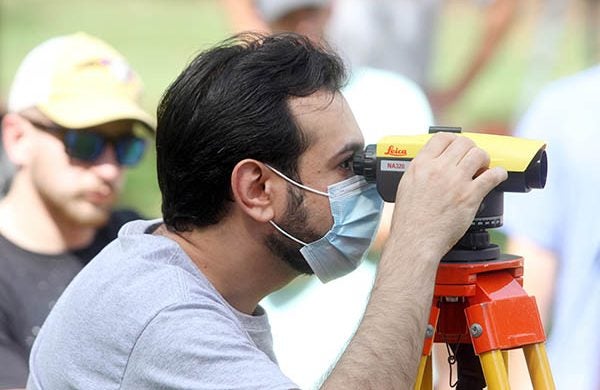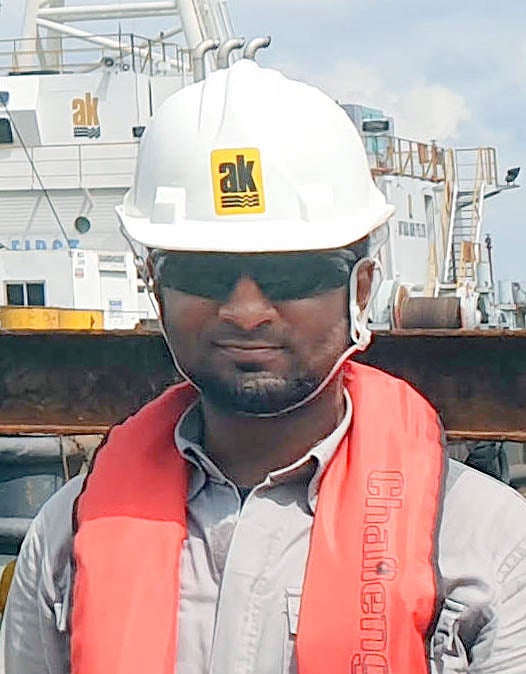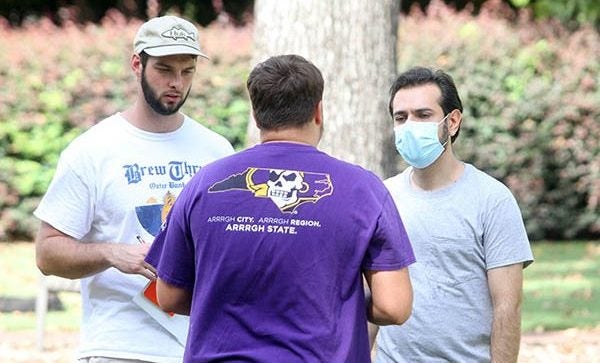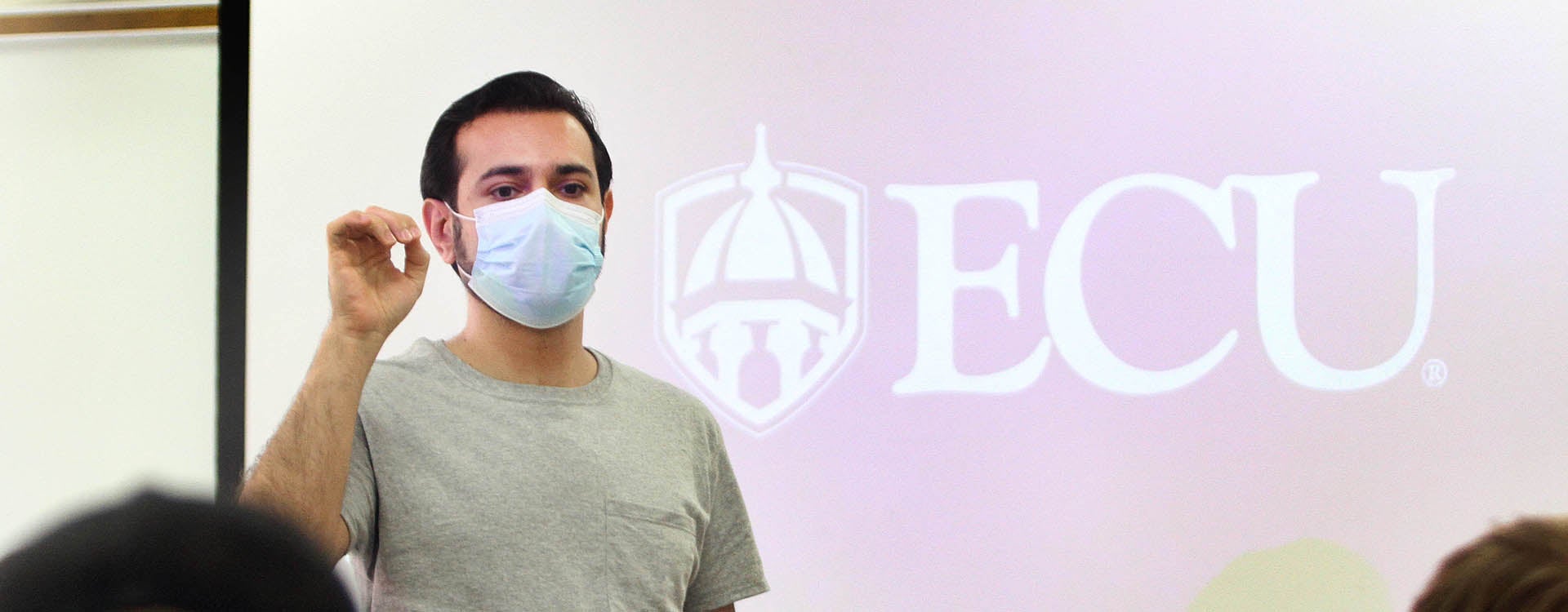SAFETY FIRST
Research of ECU construction management professor recognized
Safety of construction workers has long been a problem, and the issue is something that drives Dr. Mostafa Namian, assistant professor in East Carolina University’s Department of Construction Management.
“The construction industry is one of the most hazardous industries,” Namian said. “It actually has the highest number of fatalities.”

Dr. Mostafa Namian demonstrates use of surveying equipment during a lab.
Namian’s passion for safety in the construction industry manifests itself in his research, which has been recently recognized. A paper he produced with Dr. Michael Behm in ECU’s Department of Technology Systems and student Mohammad Khalid received the Jimmie Hinze Best Paper Award at the International Council for Research and Innovation in Building and Construction conference.
Namian is also the recipient of a Department of Labor grant to support COVID-19 safety training for construction workers.
Namian said the paper — “Safety Implications of Using UAVs in Construction: An Ethical Perspective” — stemmed from a discussion he had with Behm as Namian worked on developing safety training materials for the use of UAVs in the construction industry as part of another grant.
“Everyone is passionate about using drones because of the incredible applications that they have,” Namian said. “There are a lot of advantages such as low cost, low risk for workers, and they can be used in many areas. These days they are very efficient, very low cost. A lot of the small-size construction companies can use them. A few years ago before the UAV era, the small companies could not compete with the big companies.”

Dr. Michael Behm
From previous research, Behm knew of ethical concerns involved with emerging technology.
“A few years ago, I collaborated and published a paper with colleagues from Ireland and Australia looking at the ethical implications of safety interventions such as wearable and other technologies,” he said. “We found that other published researchers were not considering the adverse effects of their good intentions. Would you like to be constantly watched while you work? Where’s privacy? Where’s the trust? What are the adverse mental health effects of being monitored? Mostafa came to me with the notion of drones and safety. We chatted and I explained my rationale to consider ethics of the drone technology in the projects he was describing, and thus our collaborations began.”
Namian said many companies may not think about ethical issues associated with flying UAVs at construction sites.
“At first, you might not think it’s directly linked, but when we think about that, there are some ethical aspects,” he said. “When a drone is up and flying over workers, it might create some stress and anxiety and distraction. Workers can be distracted, which can’t be observed directly but can impact their performance. Another ethical concern is the fact that workers realize they are being monitored constantly, so it’s another source of stress and anxiety for them. It can be a violation of their privacy. Even though the primary goal of flying the drone at the time might not be monitoring workers but for surveying and taking pictures, workers can be concerned about that.”

Khalid Mohammad (Contributed photo)
He said security of collected data as well as the privacy of properties surrounding work sites could also be concerns with the use of UAVs in the construction industry.
Namian said the award for the paper came as a shock, and he was quick to give credit elsewhere.
“I was very surprised. I didn’t expect it,” he said. “I don’t take too much of the credit for this achievement. The idea came from Dr. Michael Behm, and Mohammad Khalid, my student who received a CET student research award, who are the co-authors, so I take minimum credit for this. But I was very surprised and very happy.”
Namian is now working on a new project thanks to a $200,000 grant from the Susan Harwood Workplace Safety and Health Training program of the Department of Labor. The goal is to provide training on infectious diseases such as COVID-19 for small construction companies on the East Coast.
“We know all work has been impacted by the pandemic, and construction is also highly impacted,” he said. “The numbers in the construction industry do not look that good. The rate of infections is higher and the rate of vaccination is lower for construction companies, so the pandemic created a lot of problems for projects, a lot of delays and a lot of issues. It disrupted the supply chain, and it impacted the ability of workers to be employed. Especially with small companies, they’ve been highly impacted.”

Namian talks to students during a surveying lab.
Namian points out that some construction workers resist the idea of safety equipment in general. As an example, required hard hats and reflective safety vests can make working outdoors in the heat troublesome. Face coverings designed to protect against COVID-19 only add to that discomfort.
“Because of the very demanding and physical — and in some cases mentally demanding — tasks, one of the issues for the workers is that masks make the tasks more challenging and more difficult for them to perform,” Namian said. “They don’t want to have them on all the time in that environment. It’s not that easy. We visited one construction site a few months ago during the pandemic, and not all workers were wearing masks, so it is a problem.”
Work on the project began Oct. 1. Namian is working on preparation of materials and expects the free training to start in early 2022.
He said because so many people already know about COVID-19, the training would be customized based on the knowledge of the participants, with three levels of training planned.
“The potential trainees will take a test first, and we will categorize them based on their safety knowledge on the subject matter,” Namian said. “We did not want to start at zero and make it boring for them if they don’t need to.”
Any construction workers or companies interested in participating in the training can contact Namian through email.
